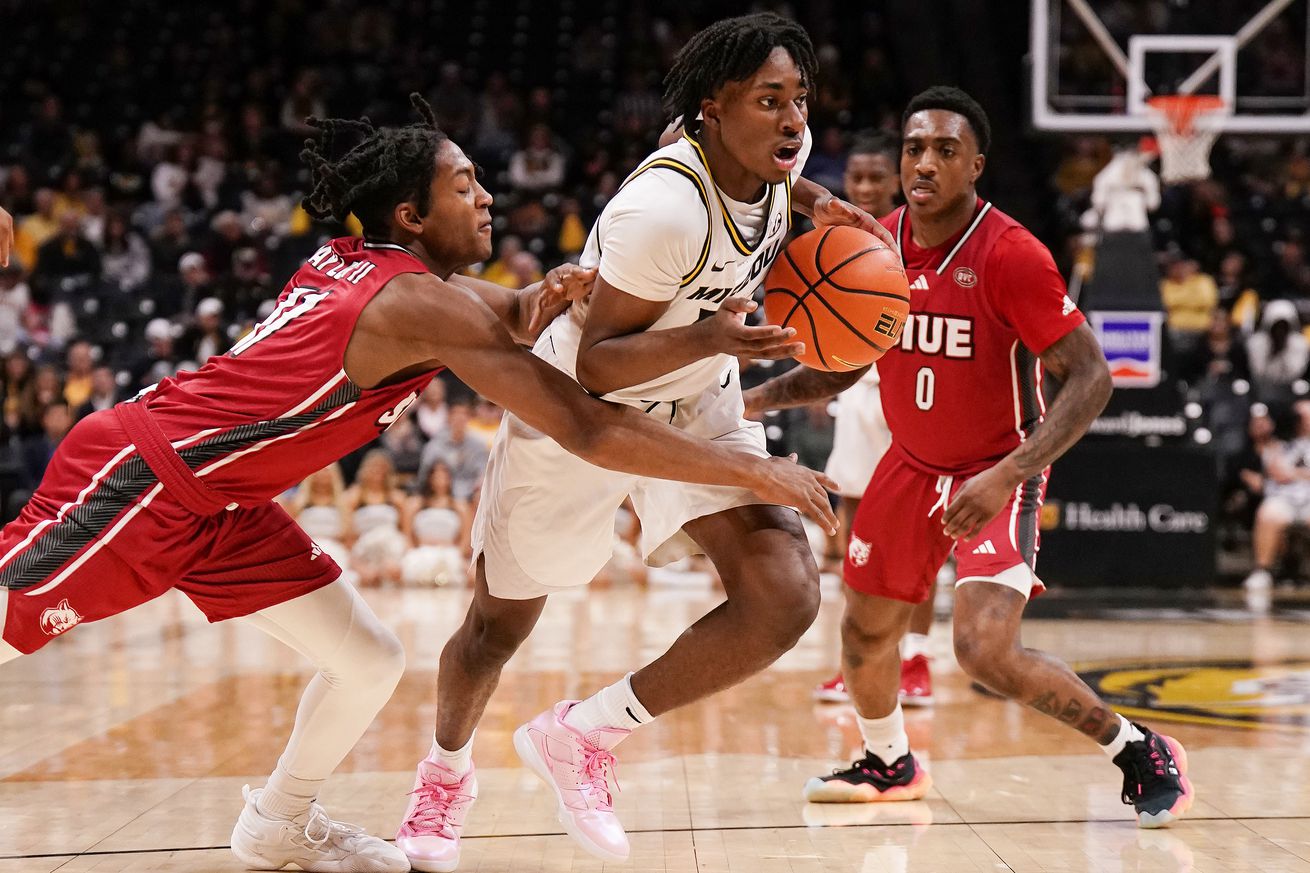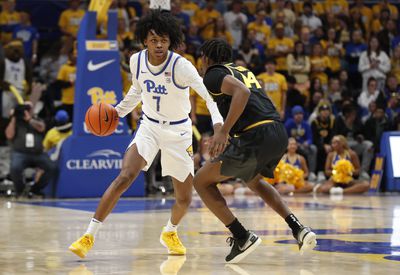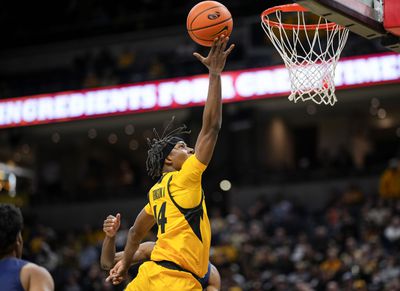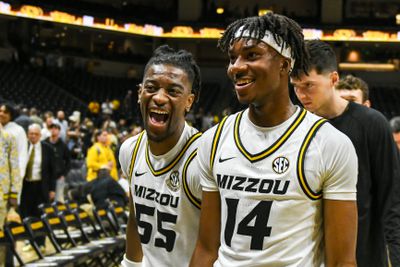
The freshman point guard’s defensive tenacity and timely touch on offense have boosted the Tigers’ backcourt through eight games.
To understand a bit of Anthony Robinson II’s on-court persona, call up Missouri’s loss to Memphis and skip ahead to the six-minute mark in the second half.
Jahvon Quinerly hunches forward and prepares to use a butt screen at the top of the key. The veteran point guard attacks left but doesn’t turn tight enough to shave Robinson off. Instead, the freshman beats Quinerly to a spot and reaches with his left hand to swipe at the ball – a split-second too late.
A whistle bleats. The nearby referee tags Robinson with a blocking foul. The whole scene is innocuous in a game MU loses by 15 points. Except Quinerly takes exception – and a couple of steps forward. “You can’t grab me,” he tells Robinson. Quickly, Jaykwon Walton spins his teammate away.
Quinerly shakes his head in the UM huddle and repeatedly mutters, “You can’t do that.” Despite Quinerly declaring he was just fine, David Jones walks him further away for an extra second or two to cool off
It turns out Robinson’s brand of on-ball defense can have this effect.
Three days later, during his breakout against SIU-Edwardsville, he earned three hand-check fouls in as many minutes – and a quick sidebar with coach Dennis Gates. Then, on Tuesday, that physicality irked Pitt guard Carlton Carrington, who knocked Robinson to the deck while awaiting an inbounds play midway through the second half.
Opposing guards might find Robinson’s mentality objectionable, but it’s hard to dispute the early results. Per Synergy Sports, he’s allowing just 0.467 points per possession, the best mark on Mizzou’s roster. Meanwhile, Robinson’s 6.9 steal percentage would rank among the top 10 nationally – if not for coming up 0.3 percentage points shy of KenPom’s cutoff for playing time.
To say his emergence is mildly surprising is an understatement. Entering the season, MU’s roster seemed abundantly supplied with ball handling. Nick Honor and Sean East remained in the fold, while Indiana transfer Tamar Bates seemingly rounded out depth. Our preseason projections had Robinson getting squeezed out.
The expectations baked in the idea that John Tonje would log more than 14.1 percent of minutes and that Connor Vanover’s integration into the rotation wouldn’t be so protracted. Instead, a limited supply of minutes remained on the shelf, and Robinson hasn’t hesitated to snatch them up.
Yet the traits Robinson’s flashed early aren’t a surprise. It was merely a matter of how quickly they might translate – and whether he’d have enough time to put them on display. Today, let’s walk through how he’s made such a favorable impression.

Charles LeClaire-USA TODAY Sports
What does Robinson supply on defense?
There’s never been much doubt that Robinson possessed all the tools to be an elite on-ball stopper. What was missing, however, was a bit of restraint.
Robinson’s quick first slide, length, and active hands at Florida State University School resulted in a penchant for gambling. As we’ll see, there are situations where his risk appetite is a bit too much, but it’s not hard to see prudence when you watch him defend ball screens.
While MU’s switch-heavy, there are still instances where it wants the on-ball defender to fight over the top of a screen. That’s no issue for Robinson. It was the base coverage used at FSUS. And even if he can’t turn a dribbler, he shrinks the distance enough to avoid getting clipped and turn cut off a tight attack angle.
Watch how often a dribbler disengages, backs out, resets, and attacks again. While Robinson needs a bit more functional strength, he rarely gets put on tilt when a defender tries to create separation with an off-arm.
I’ve also included a few clips of Robinson working in isolation because it shows another tactic MU uses against drivers. Notice how Robinson stays attached to the hip of some drivers. There’s no snake dribble. No putting him in jail, either. Instead, Robinson acts like an usher gently walking a ball-handler toward a rim protector, who makes a modest rotation to wall up.
In eight games, Robinson’s allowing a paltry 0.400 PPP when guarding pick-and-rolls, according to Synergy Sports. That’s on a modest volume of 1.3 possessions per game, one below the Division I median. Still, it ranks eighth among the better marks among SEC players.
Early on, Mizzou also showed a willingness to mix up approaches to handling switches and ball-screen coverages based on its personnel. When Robinson, Tamar Bates, and Aidan Shaw check-in, there are stretches where the Tigers might ice side pick-and-rolls.
If Jordan Butler’s on the floor, MU seems more tolerant of playing a big man at the level of the screen and hard-hedging. By contrast, inserting Connor Vanover might mean sitting a big man in deep drop coverage. But a constant is the ability to apply steady pressure on the ball – a need Robinson met.
He’s also proved essential in another way: closing down shooters. It’s grunt work and the humdrum task that can become thankless – unless done poorly or not at all. Last season, MU was, to put it politely, atrocious. It ranked 346th in the country at allowing catch-and-shoot jumpers and 278th in efficiency.
If nothing else, the Tigers found the floor. Any effort, no matter how modest, would be an improvement. Per Synergy, MU currently cedes 16.6 of those looks per game, ranking 246th nationally. Their efficiency is still alarming, but even modest progress starts by cutting down the volume of — or reliably contesting — those attempts.
Sometimes, off-ball defense is vexing for a freshman in a game where the talent level and speed have ramped up. However, Robinson’s allows 0.60 PPP on jumpers, and that efficiency shrinks to 0.38 PPP on catch-and-shoot looks. How has he done it? Take a look.
As we’ve covered before, Mizzou’s defense is defined by aggressive help, whether that’s toward the middle gap or collapsing down. Long recoveries and scrambles are a way of life.
For Robinson, his wingspan makes those situations more tolerable. Sometimes, Robinson gets liftoff a full step early – effectively closing out short — and still alters some jumpers. It’s also handy when the Tigers are a bit slow sorting out cross-matches and leave a shooter uncovered.
Close-outs are a handy highlighter to underline the difference between Robinson and a vet like Honor. While Honor was stout as an on-ball defender, opponents exploited him when he rotated hard to the middle of the floor. Unfortunately, it’s still happening, with Honor allowing 1.75 PPP on guarded catch-and-shoot attempts.
Inserting Robinson balances the books. MU gets to apply the same clamps to dribblers, boosts turnover generation, and doesn’t pay a tax from behind the 3-point arc.
That same length and timing even make a difference when Robinson plays the helper role.
Robinson converts a simple stunt into a gap from a rote task of slowing down a driver into a chance to strip the ball and kickstart a transition opportunity. There are also trips where switches early in a possession result in him acting as a low man. Again, his length helps offset a 6-foot-3 frame when rotating into the middle gap, whether to force a guard into a floater or walling up on a putback.
Feeding Robinson minutes, however, isn’t without modest drawbacks: fouls. He’s averaging five of them per 40 minutes, according to KenPom’s data. Robinson also gives away as many free throws (20) as shot attempts (22), a ratio that ranks in the fifth percentile nationally. That’s mildly impressive, considering he’s only been booked for two shooting fouls.
Then you review his film, and it all makes sense.
There’s something admirable about Robinson’s effort at a high pick-up point. But he’s still greedy in trying to turn a dribbler to pick their pocket. There’s a happy medium where he makes that ball handler work to get upcourt and initiate a set. However, these types of moments start to grate on guys like Quinerly and Carrington, creating the kind of discomfort and agitation that can seep into the decision-making.
Eventually, Robinson will learn how to modulate that intensity, but there’s also something admirable about a freshman who’s not shy about trying to impose his will.

Jay Biggerstaff-USA TODAY Sports
How is he impacting Mizzou’s offense?
Three years ago, I caught mild flak for making the following statement: Mizzou was better when it swapped Drew Buggs for Xavier Pinson.
Without a doubt, Pinson possessed creativity and virtuosity with the ball in his hands. Yet moments of inspiration were undercut by coughing up the ball almost 21 percent of the time. And when Pinson reached the rim, he made less than half his shots and averaged 0.98 points.
Buggs wasn’t nearly so audacious, but MU’s offense was more efficient. Why? The touches Pinson consumed funneled through Buggs to teammates who took higher-value shots.
To a certain extent, you can say the same about Robinson’s early role. The freshman’s 19.6 usage rate is modest, but he only attempts a shot every sixth trip down the floor. As we’ll see, simplicity defines his facilitating, but it’s produced a 2.8 assist-to-turnover ratio.
Put simply, Robinson rarely presses, takes shots within the natural flow of a set, and moves the ball where it needs to go.
That spirit shows up quite often when Robinson’s pushing the ball in transition. It’s also been a constant since I started watching him on the grassroots circuit. Robinson gets his head up, scans, and decides within one or two dribbles. He is confident in hitting teammates running the channels or a big sprinting to the rim.
Yet we’ve also glimpsed Robinson making comfortable reads as a trailing teammate sets a drag screen. So far, that simple action has been coupled with a Tiger lifting from the weak side corner, creating an easy kick out for a catch-and-shoot from the slot.
Similarly, he doesn’t overcomplicate matters playing out pick-and-roll.
Often, those touches are in secondary actions with five-out spacing. A spread screen in the middle of the floor sets up a kick to East on the weak side. Playing in a middle PNR, he’s patient enough to hold Noah Carter’s defender long enough to tee up a pick-and-pop. A ghost screen by East is window dressing for Carter to lift into space for Robinson’s ball reversal. And even when MU’s freestyling, he hits East as he breaks off on a back cut.
Robinson is equally opportunistic probing for shots out of those ball screens. Interestingly, he’s similarly inclined to reject them, particularly those set on an empty side of the floor and attack space toward the baseline.
That same flexibility applies in the rare instances Robinson’s benefited from a handoff. Again, he breaks with the modern tendency of guards to use those actions to ramp up speed and get downhill. He’s fine rejecting the screen and reversing slightly before driving. He recognizes a defender going under as an opportunity to pull from long distance.
Robinson’s always been at ease getting into his shot off the bounce, but it was an open question about how quickly it would translate. Well, he’s averaging 1.667 PPP on these types of touches, per Synergy. Inevitably, that efficiency will dip as Robinson boosts his shot volume. Yet the fact he’s finding actions that get him to his preferred spots without dominating the ball should spur some optimism.
Folding in Robinson’s work as a set-up man reinforces how quickly he’s acclimated. Accounting for his assists bumps Robinson’s offensive to 1.508 PPP — tops among SEC players who amass a similar number of touches per game.
Chew on this, too: Robinson’s only shooting 25 percent from beyond the 3-point stripe, including 1 of 8 on catch-and-shoot attempts. For example, he’s made just 1 of 4 attempts when getting his feet set and launching in rhythm.
The results have been about the same when Robinson’s relocating to space, whether lifting from a corner or filling in behind a driver.
Let’s say Robinson was shooting at the median clip for Division I. Under those conditions, he’d have notched two more makes — and raised his scoring average by about a point per game. That said, a freshman encountering early bumps as a floor spacer isn’t unheard of, and those opportunities aren’t a focal point of Robinson’s skill set.
Reserve any grumbling for Robinson’s handiwork as a scorer in the open floor. He’s averaging just 0.583 PPP in transition, and the clips show he’s left at least eight points unclaimed.
That fits into a more significant issue that’s plagued MU but has been underplayed in how we talk about this version of the Tigers. They’ve been mediocre playing on the break, averaging 0.975 PPP and sit at 275th for efficiency. Last season, they ranked 72nd. Cashing in those high-value rim attempts is vital to adding up the arithmetic underlying Gates’ system.
It also presents a tempting thought: What would Mizzou have on its hands if Robinson performed clean-up work in those areas?

Cal Tobias/Rock M Nation
Who are Robinson’s collaborators?
We also need to talk about the company Robinson keeps.
Nearly 80 percent of his minutes are spent as a nominal combo guard, most of which have come running alongside East. Now, that shouldn’t be jarring for Robinson. At Florida State University School, he split lead-guard duties with Tre Donaldson, who is now in his sophomore campaign at Auburn. Robinson occasionally brings the ball up and triggers the offense, but working with East means he’ll be a secondary creator for the Tigers.
Sifting lineups only reinforces that distinction. Using Pivot Analysis’ cutting tool, we can isolate the groups that have logged heaviest use with Robinson at the off-guard spot. That breakdown is below.
While there’s not a dominant group, these quintets account for roughly 40.3 percent of Robinson’s playing time, while their 48.2 net rating is four-times better than MU’s baseline efficiency. From there, we can isolate Robertson’s most common collaborators.
What’s notable is the lack of jockeying between Robinson and Bates over the same role. Instead, the former Hoosier easily slides down one spot in the positional pecking order and spends the bulk of his time as a straight wing. Slotting those two alongside East has also the effect of yielding a gaudy 68.2 net rating.
Obviously, some caveats apply. At only 43 possessions, the sample size is small, comprising just 8 percent of the Tigers total. None of them were logged against Memphis, Minnesota or Pitt, and a portion of that sample overlaps a 22-0 run that buried South Carolina State. Stripping out that run, though, still leaves the backcourt of East, Robinson and Bates sporting a 35.1 net rating.
Fortunately, we won’t have to wait long to see whether those results start deflating. Wichita State, ranked No. 92 in KenPom, pulls into Mizzou Arena today. A week from now, the Tigers venture west to face Kansas. And it wraps down December with two neutral-court tilts against Seton Hall and Illinois. How much shine comes off between now and then? What if it withstands that scrutiny? And if it does, would MU amend its rotation.
So far, Gates has made good on his word to play Honor and East for longer stretches. They share the floor nearly 50 percent of the time. Yet the impact has been a relatively modest 3.1 net rating. That’s not much better than the plus-1.4 mark the tandem produced a season ago. That insight is only underscored when you review the performance of MU’s most-used backcourts.
Look at what happens when swapping out Honor for Robinson alongside East and Bates. MU’s net rating improves by nearly 89 points per 100 possessions. It’s unlikely Honor’s completely mothballed, but eight games of data hint that feeding more minutes to lineups involving Robinson might not be the worst idea.
Doing so might not be all that painful, either. For example, if Honor and East shared the court at the same level they did last season, it would carve out six additional minutes per game. And it might prove necessary just to keep Robinson’s floor steady. Why? Let’s say John Tonje finds his form. Expanding his role requires siphoning PT from somewhere. Curbing the reliance on East and Honor wouldn’t demand Robinson making a sacrifice.
Again, these scenarios might sound foolish a month from now. Yet the fact we’re entertaining them — even loosely — is a testament to Robinson’s early impact.